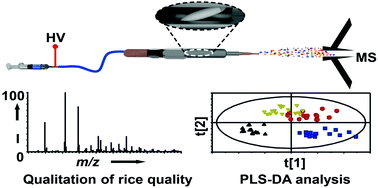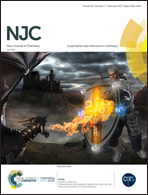Differentiation of cultivation areas and crop years of milled rice using single grain mass spectrometry†
Abstract
The quality of rice, a widely served staple food in the world, is usually assessed based on the levels of free fatty acids (FFAs). Therefore, a method for the rapid detection and quantification of FFAs in rice grains or even a single rice grain would make rice quality evaluation easier. In this study, we developed a single grain electrospray ionization (SG-ESI) source where a single grain of rice was placed in a small chamber in-line with an electrospray ionization source for mass spectrometric analysis. The characteristic fingerprint of every single rice grain was rapidly recorded by the single grain mass spectrometry without tedious sample pre-treatment (such as off-line extraction, centrifugation and/or separation). Semi-quantitative determination of typical FFAs and pesticides in the single rice grain samples was successfully achieved, providing the limits of detection (LODs) of 0.11–1.30 ng g−1 and the recovery rates of 77.68–91.52% (RSDs ≤ 9.54%). The rice grains of different cultivation areas and/or storage times were differentiated by the full scan mass spectral data processed using multivariate statistical analysis. The experimental results demonstrate that the established single grain mass spectrometry is a useful tool for the direct analysis of rice grains with minimal sample preparation, low sample consumption, high sensitivity and high throughput.



 Please wait while we load your content...
Please wait while we load your content...